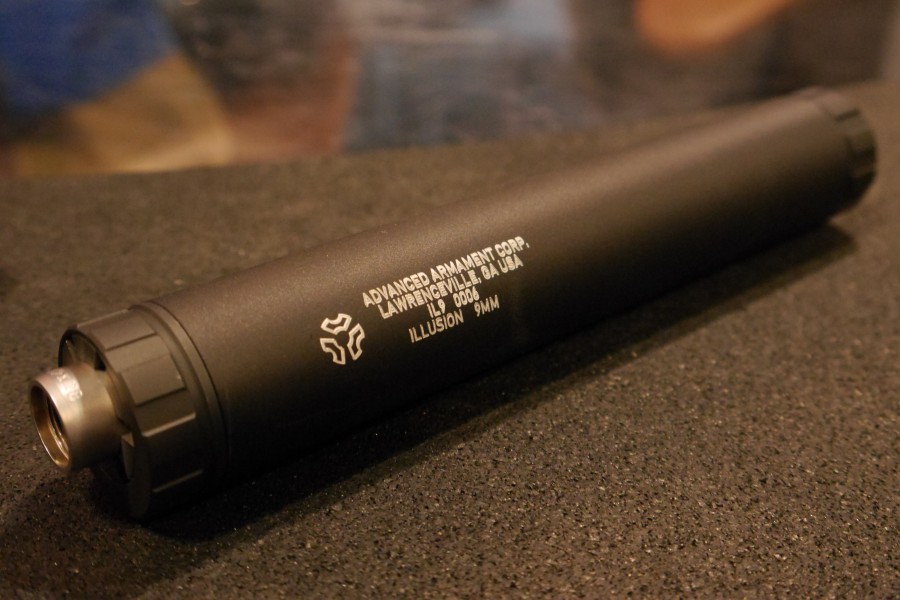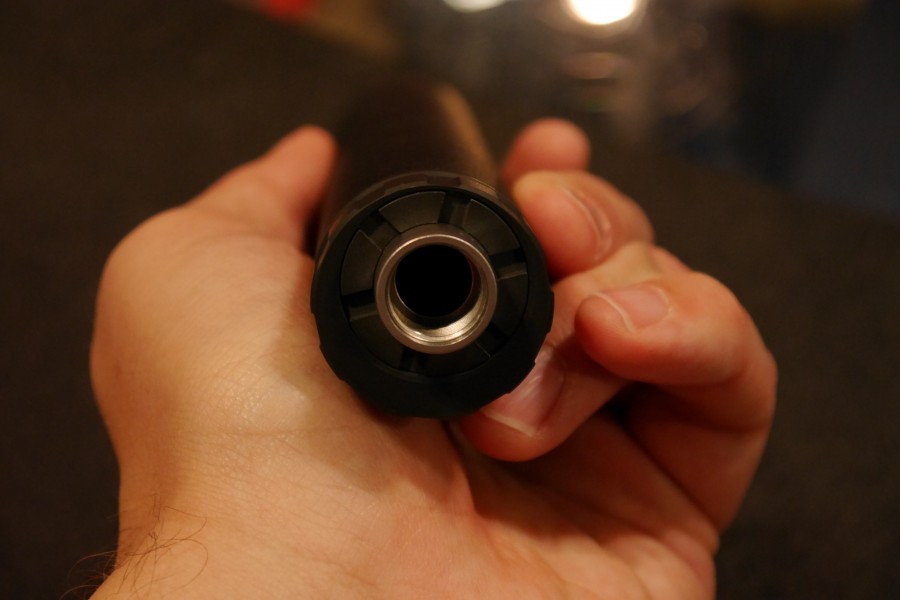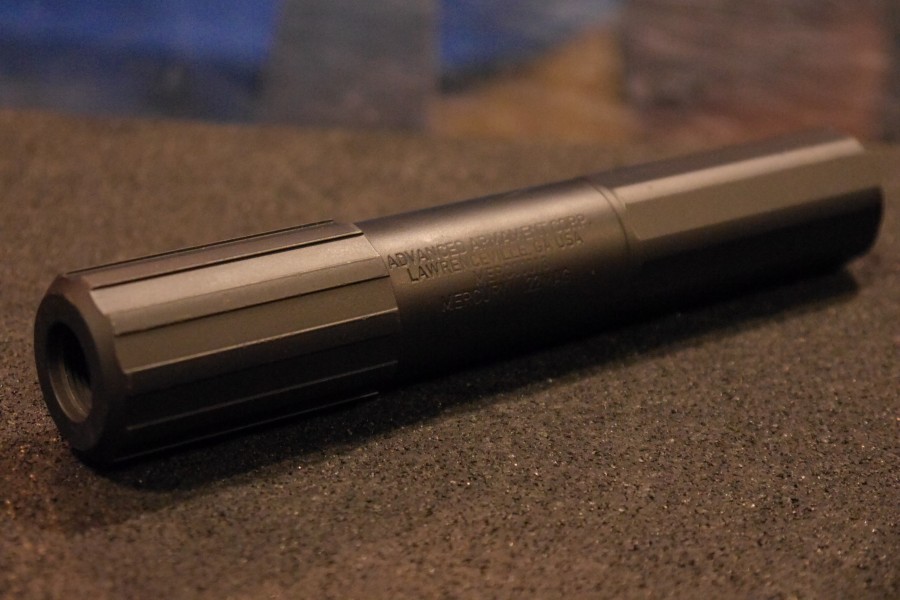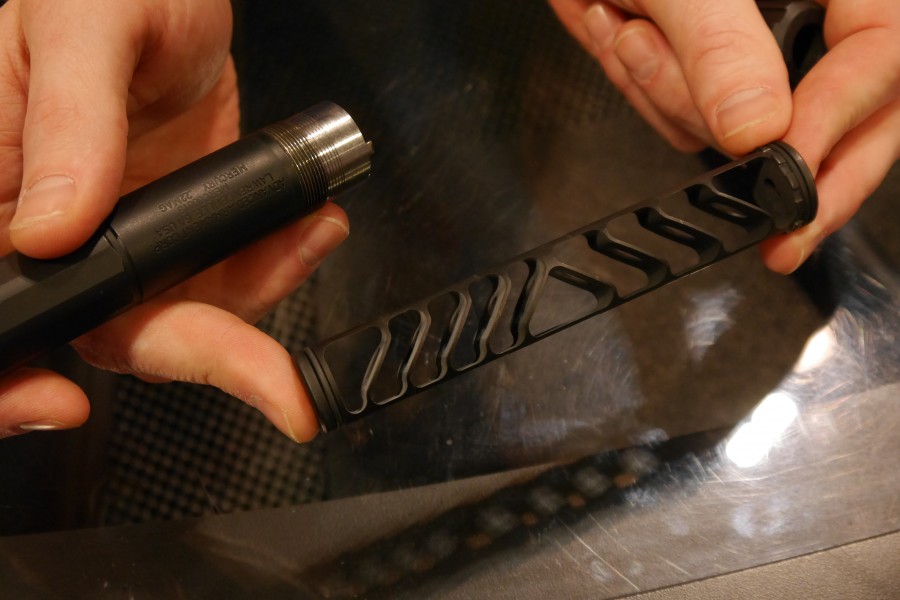The biggest pain in the ass for pistol silencer owners is figuring out how to accurately shoot with the damned can attached. Most silencers obscure the sight picture for standard height sights, and the only options available are extended “silencer” sights (which look ridiculous) or a laser sight of some sort. That’s one of the reasons that my nightstand gun (a SIG SAUER Mk25 with AAC Ti-Rant 9mm can) has a set of Crimson Trace lasergrips, so I can actually figure out where I’m aiming. AAC thinks they’ve got a better solution: the Illusion silencer.
Take a look back to some of the very first advertisments for Maxim Silencers and you’ll see off-center silencers galore. Referred to as “eccentric” silencers in the modern market, the idea is that you place more of the volume of the can below bore level than above, and you can have the same overall can volume without needing taller sights. SilencerCo’s Osprey has been pretty much alone in the market for eccentric cans, but the Illusion seems to offer a nifty alternative.
The pistons will be available in 1/2×28 and 13.5×1 mmL, and offer more teeth than the Ti-Rant cans to allow the shooter to time the can onto the pistol properly. The baffle stack is individual K baffles, and the can is user serviceable for cleaning. The baffles are keyed to ensure that they only go back together in the right orientation (since the hole is no longer in the middle) and the front baffle doubles as a re-assembly tool. After owning a Ti-Rant 9 with a similar baffle configuration I’ve become more of a monocore advocate for dirty calibers, but there’s no doubt that it works. MSRP on this puppy will be $799.99 — $92 and change less than SilencerCo’s full size Osprey, and $40 less than the shortie.
Something that does sport a monocore design is their latest rimfire silencer.
Dubbed the “Mercury,” the can seems designed with new silencer owners in mind. Instead of a flimsy feeling outer shell like the Prodigy (which I own), the container feels tough and durable. That’s not just a “feeling” either — instead of being .22lr only like some of the predecessors *COUGH COUGH Prodigy COUGH COUGH*, the can is rated for .22 MAG, .17 HMR, and .17 HMR II as well. Essentially, if its rimfire, its good to go. Which is cool.
Instead of needing to fiddle with individual baffles, the Mercury uses a monocore design. I find it much easier to clean the monocore stuff than the take-down baffle stacks, and disassembly and reassembly is definitely easier as well. That’s why it rates as being a better idea for newer owners. The Mercury takes that ease of disassembly a bit further by providing a larger gripping surface for users to apply some torque and get that can apart, which is very much appreciated.
The baffle stack looks like a modified Prodigy baffle stack, which works for me (nothing to improve, really). MSRP is $399.99, which is $100 under MSRP from the Prodigy. In short, I don’t see why anyone would buy anything else from AAC’s rimfire offerings. If it works as well as advertised, this will be very slick.








There you go hating on AAC again 🙂
Why would you need a silencer on your nightstand gun?
Tinnitus sucks.
Maawp. Maaaaawp.
+1 Archer
Is anybody gonna answer the phone?
My nightstand gun has a liberty mystic on it because shooting guns indoors is very disorienting.
Mystic on mine also.
AAC Element 2 is my rimfire can. Monocore could be nice, but I like how the baffle stack keeps the inside of the tube clean. Easy to throw the baffles in the ultrasonic tank, but ultrasonic cleaning the tube eats away at the coating. Even Cerakote and whatever else, if it’s a coating it’ll disappear after a while.
That rimfire core looks like they cut up a SilencerCo Sparrow and said-“let’s just do this”.
At least it’s pretty clearly machined from a single piece of material. The monocores that are literally washers welded into a cut up tube drive me insane.
I thought the biggest pain in the ass for pistol suppressor owners was the $200 tax……or the upwards of 6 months or more wait time…….or the price of the can itself.
I’ll put up with a little holdover if the 3 above go away.
Thats funny since the Sparrow core is a direct rip off of the Thompson Machine Zephyr core.
They show these at the NRA show? Didn’t see them when I went by.
Kalifornia. No cans allowed. *sob*
You should be happy about that! There will be no assassins in Kommufornia!
It’d be nice to know how big each of these cans are.
Digital calipers are not needed, just a small ruler/scale marked to the nearest quarter- or eighth-inch, that could lay alongside a can in a photo. Cheap pocket-sized measuring tapes are cheap!
Also, what are the innards and outer case made of? Stainless steel, aluminum, titanium, what? Baffles, especially.
Comments are closed.